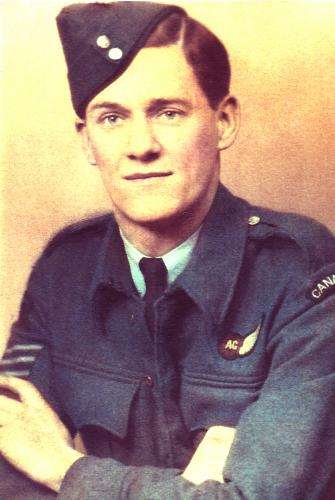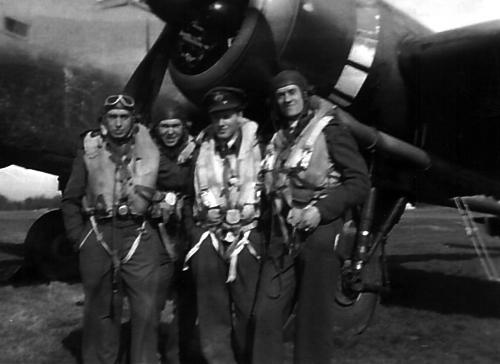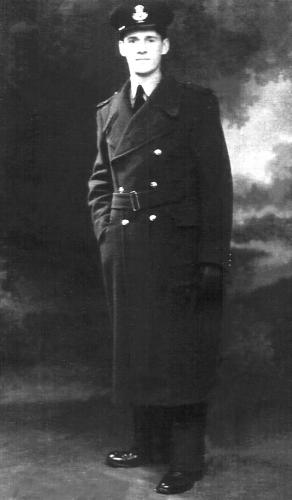Lorne Sharp and his Hampden story

Lorne Sharp, shown after his promotion from Flight Sergeant, in his Pilot Officer uniform
Have you ever wondered about the story behind the aircraft in the Museum’s collection? This summer a group of visitors provided some details of the wartime operations of one of the Museum’s rare aircraft – the Handley Page Hampden.
Some of the visitors had a father who was a crewmember on Hampdens flying out of bases in England during World War 2. They had gathered family members from Canada and the USA at the Museum to see the very type of aircraft that Grampa flew in. He was an Air Gunner, described as;
Air Gunner – The role was to defend the bomber using the aircraft’s machine guns. In the early stages of the war, usually an enlisted man, he could hold any rank but was most often a sergeant, although some air gunners were commissioned officers. An Air Gunner wore a single-winged aircrew brevet with a wreath containing the letters AG on his tunic, above his left breast pocket denoting his trade specialization.

The family were kind enough to share some of the personal details of his wartime service.
As an introduction here is an extract of the squadron records from the 415 Squadron Association, RCAF, relevant to the service of their father, Lorne Sharp of Crossfield, Alberta.
Pilot: Flight Lieutenant G.H. Lawrence
Navigator: Pilot Officer K. R. Maffre (Longueuil, QC)
WO/AG: Pilot Officer L. S. Sharp (Crossfield, AB)
WO/AG: Flight Sergeant R. E. Volney (Montreal, QC)
The initial aircrew on 415 Squadron, of which your father was one, joined the unit between November 1941 and January 1942. During this time pilots had to qualify on 2 or 3 aircraft types. For the most part, crew training started in the New Year. The first operational flight flown by 415 occurred on 21 April 1942.
In the Operational Record Books, the first mention of Lawrence’s crew occurs on 5 May 1942. They were repositioning in preparation for their first Anti-Submarine patrol which occurred on 8 May 1942. Their first attack occurred on 30 May 1942 against a convoy.
The crew was assigned to “B” Flight. In August 1942 your father was assigned a secondary duty, Squadron Deputy Entertainment Officer.
On 27 October 1942 the crew flew their 7th operational mission. While returning to base, the aircraft lost one engine and had electrical malfunctions. The aircraft was ditched in Padstow Harbour at 2240 and the crew was rescued 15 minutes later. The report of the accident said your father was uninjured and that he handled the signals to attract the rescue dinghy. The crew commander, F/Lt Lawrence, suffered a number of injuries, which sidelined the crew.

The crew of a 415 Squadron, RCAF Hampden with Air Gunner Lorne Sharp at right
The following is in Lorne Sharp’s own words, written for one of his grandchildren.
“Subsequent to this trip, we were waiting for what would be me last flight, and a real important war operation. Several of our planes took off, with sealed orders and instructions to torpedo anything that came out of the French coast towards us, for we were flying to what later was revealed as Gibraltar. Unknowing, we were air cover along with many other craft for a huge 500 ship convoy carrying American tanks, etc., to be taken inside the Mediterranean to be landed at Oran, in Tunisia. This venture, by the way, was successful and a real contribution to helping the British rout General Rommel and take back North Africa. But it was disaster for me. After 20 minutes out from land, we lost one motor (got hot). Spiralling down to the sea from 2000 feet, it looked to be all up! I didn’t have time to get an SOS out so I simply screwed down the Morse key and the resulting continuous squeal would be picked up by the base and at least they would know where we crashed. But as we neared the water, the dead motor caught again and with the extra power we flattened out a mere 100 feet off the sea! Now what to do, should we go on, or return to base? We elected to return. But before we sighted England (we were off Land’s End or “The Lizzard”, as this corner of the country was known as) the engine failed and all of us knew what was ahead. I immediately sent off an SOS, and the pilot, after several tries to land on the rock-strewn beach gave up and ordered ditching procedure. We dumped our flying boots, parachutes and guns and got ready. After seeking to alert the coast watchers by firing off many Very Pistol shells, we had little hope that this “Flying Matchbox” as the plane was nicknamed would survive a crash at sea. After all, these old bombers were obsolete before the war actually broke out.
“But God in His mercy was watching. The plane bounced and bent the propellers, and was gone below the surface in 80 seconds. We managed to launch our dinghy, and were picked up by a Canadian Air Sea Rescue vessel in 15 minutes! Our landing time, 10:42, October 27th, 1942. Bright moonlight night. By 12 midnight we were in bed in an English Naval hospital, having had a shot of rum, a cup of tea and all was well! The next day I caught influenza and the resulting chronic kidney infection invalided me out of the war, after six dreary hospital months.
“Contrary to opinions, I never was actually shot down, nor did my coming down in the Bay of Biscay contribute to my illness. I only got my feet wet that night!”
Royal Air Force records confirm this event –
27/10/1942 2240hrs Handley Page Hampden P5394 of 415 Sqdn RCAF detached to RAF St Eval on returning from a Shipping Strike crashed into the sea off Pentire Point 4 miles N of Padstow Police Station. Due to engine failure & being lost. The aircraft sank but the four occupants were rescued one with slight wounds.

Lorne Sharp in his uniform as an officer in the RCAF
A newspaper clipping from the visiting family tell of another dramatic event that the crew encountered;
“As we approached the vessel, the escorting flak ships turned their attention to us and we pulled up to drop our load. As we completed our run over the vessel, flak ships placed on the other side of it opened up with a terrific barrage and we felt our aircraft lurch as the stuff hit. I brought our aircraft down almost to the ‘deck’ and we got out of town.”
There were six holes in the “kite” but the trip home was made without difficulty and the crew had the satisfaction of knowing that their bombs had struck the target. A shout from Flt. Sgt. Reg Volney of Montreal, air gunner, signalled their success as the aircraft sped from the range of the flak. Other members of the crew were PO Ken Maffre, Longueuil, Que., Navigator and PO Lorne Sharp of Crossfield, Alta.
The Legion Magazine provides more details of 415 Squadron’s activities with the Hampden;
No. 415 Sqdn. formed at Thorney Island, Sussex, on Aug. 20, 1941, worked up on Beauforts, and became operational on Hampdens in April 1942. The squadron often flew in company with its New Zealand sister squadron. Their most effective weapon was the Mark XII torpedo, but the Hampdens also operated with ordinary bombs and sometimes with depth charges. Indeed, their first anti-shipping mission on May 20, 1942, was with bombs; they did not attack a target with “fish” until July 1, 1942. Although No. 415 Sqdn. submitted several claims for enemy ships sunk or damaged, they did not register a solid success until April 10, 1943. The squadron operated Hampdens until September 1943; after that they sought out enemy shipping with bombs alone, carried in Wellington and Albacore aircraft.
The squadron’s theatre of operations ranged from Norwegian waters to the Dutch coast and southward to the Bay of Biscay. Daylight operations were rare. Instead, the Hampdens worked at night, without radar, in concert with Hudson aircraft which dropped flares to create silhouettes of the targets. Such tactics ruled out surprise attacks, and the Hampden crews were met routinely with intense flak.
No. 415’s first major success occurred on April 10, 1943, and it is an excellent example of the perils and challenges met. At 4:32 p.m., the squadron dispatched five aircraft from St. Eval in the United Kingdom, bound for the Bay of Biscay. The target was the 6,240-ton Himalaya, a cargo vessel intent on breaking out of Brest, France. The Hampdens linked up with a small Wellington bomber force, but when it was apparent that the Wellingtons were following the wrong track, No. 415’s crews broke away. Almost at once they found the Himalaya and attacked at 8:31 p.m. The ship and its four destroyer escorts threw up a curtain of flak. One Hampden was shot down and every other aircraft sustained damage. One machine returned to base on one engine, escorted by two less seriously damaged Hampdens. The Himalaya was so crippled that it had to return to Brest; it was never able to run the blockade.
The Hampden had a crew of four: pilot, navigator/bomb aimer, radio operator and rear gunner, however the radio operator also doubled as a gunner. First flown in 1936 and conceived as a fast, manoeuvrable, ‘fighting bomber,’ the Hampden had a fixed .303 in. Browning machine gun in the forward fuselage. To avoid the weight penalties of powered turrets, the Hampden had a curved Perspex nose fitted with a manual .303 in. Vickers K machine gun and a .303 in. Vickers K installation in the rear upper and lower positions. Later aircraft had a pair of .303 machine guns in each of the two rear gun positions. Following retirement from bombing operations, many Hampdens were modified as torpedo bombers.
In RCAF service in Canada, Canadian and British-built Hampdens were used to train torpedo-bomber crews at 32 OTU, Patricia Bay, BC.
For more on the Hampden and the Museum's example on display, go to;